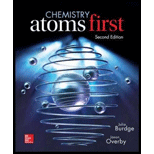
Concept explainers
Lysozyme is an enzyme that cleaves bacterial cell walls. A sample of lysozyme extracted from egg white has a molar mass of 13.930 g. A quantity of 0.100 g of this enzyme is dissolved in 150 g of water at 25°C. Calculate the vapor-pressure lowering, the depression in freezing point, the elevation in boiling point, and die osmotic pressure of this solution. (The vapor pressure of water at 25°C is 23.76 mmHg.)
Interpretation:
For given solution vapor pressure lowering, freezing point depression, boiling point elevation and osmotic pressures to be calculated.
Concept introduction
Boiling point elevation
Where,
Freezing point depression
Where,
Osmotic pressure is the pressure that is needed to stop osmosis. Osmotic pressure of the solution is directly proportional to the concentration of the solution. We can calculate osmotic pressure by using this formula is given by,
Where,
Vapor pressure lowering: Vapor pressure lowering is one of the colligative properties. Pure solvent has higher vapour pressure than its solution have non-volatile liquid. Thus vapour pressure lowering guide boiling point elevation.
Where,
Answer to Problem 13.94QP
Answer
Vapour pressure lowering of the solution is
Freezing point elevation is
Boiling point elevation is
Osmotic pressure is
Explanation of Solution
Explanation
Given data
Molar mass of egg white =
Amount of enzyme which is dissolved in water =
Amount of water =
Vapor pressure of water =
Calculation of number of moles in lysozyme and water
Molecular mass of water =
By plugging in the value of amount of Isozyme and molar mass of egg white, mole of Isozyme has calculated. Similarly, by plugging in the value of amount of water and molar mass of water, mole of water has calculated.
Calculation of vapour pressure lowering of the solution
By plugging in the values of mole fraction of Isozyme and vapour pressure of water, vapour pressure lowering of the solution has calculated.
Calculation freezing point depression of the solution
Molal freezing point depression constant =
By plugging in the values of molal freezing point depression constant and molality of the solution, freezing point depression of the solution has calculated.
Calculation of boiling point elevation of the solution
Boiling point elevation constant =
By plugging in the values of boiling point elevation constant and molality of the solution, boiling point elevation of the solution has calculated.
Calculation of osmotic pressure of the solution
As known above, we assume the density of the solution is
By plugging in the values of molarity of the solution, ideal gas constant and temperature in Kelvin, the osmotic pressure of the solution has calculated.
Conclusion
Vapour pressure lowering of the solution was calculated as
Freezing point elevation has calculated as
Boiling point elevation has calculated as
Osmotic pressure has calculated as
Want to see more full solutions like this?
Chapter 13 Solutions
Chemistry: Atoms First
- Calculate the freezing point of 525 g of water that contains 25.0 g of NaCl. Assume i, the vant Hoff factor, is 1.85 for NaCl.arrow_forwardWhat would be the freezing point of a solution formed by adding 1.0 mole of glucose (a molecular compound) to the following amounts of water? a. 250 g (0.25 kg) b. 500 g (0.500 kg) c. 1000 g (1.000 kg) d. 2000 g (2.000 kg)arrow_forwardDefine the terms in Raoults law. Figure 10-9 illustrates the net transfer of water molecules from pure water to an aqueous solution of a nonvolatile solute. Explain why eventually all of the water from the beaker of pure water will transfer to the aqueous solution. If the experiment illustrated in Fig. 10-9 was performed using a volatile solute, what would happen? How do you calculate the total vapor pressure when both the solute and solvent are volatile?arrow_forward
- A 1.00 mol/kg aqueous sulfuric acid solution, H2SO4,freezes at 4.04 C. Calculate i, the vant Hoff factor,for sulfuric acid in this solution.arrow_forward(a) If you dissolve 10.0 g (about one heaping teaspoonful) of sugar (sucrose, C12H22O11) in a cup of water (250. g), what are the mole fraction, molality, and weight percent of sugar? (b) Seawater has a sodium ion concentration of 1.08 104 ppm. If the sodium is present in the form of dissolved sodium chloride, what mass of NaCl is in each liter of seawater? Seawater is denser than pure water because of dissolved salts. Its density is 1.05 g/mLarrow_forwardSome ethylene glycol, HOCH2CH2OH, is added to your cars cooling system along with 5.0 kg of water. If the freezing point of the water-glycol solution is 15.0 C, what mass of HOCH2CH2OH must have been added?arrow_forward
 Chemistry & Chemical ReactivityChemistryISBN:9781337399074Author:John C. Kotz, Paul M. Treichel, John Townsend, David TreichelPublisher:Cengage Learning
Chemistry & Chemical ReactivityChemistryISBN:9781337399074Author:John C. Kotz, Paul M. Treichel, John Townsend, David TreichelPublisher:Cengage Learning Chemistry: An Atoms First ApproachChemistryISBN:9781305079243Author:Steven S. Zumdahl, Susan A. ZumdahlPublisher:Cengage Learning
Chemistry: An Atoms First ApproachChemistryISBN:9781305079243Author:Steven S. Zumdahl, Susan A. ZumdahlPublisher:Cengage Learning Chemistry: The Molecular ScienceChemistryISBN:9781285199047Author:John W. Moore, Conrad L. StanitskiPublisher:Cengage Learning
Chemistry: The Molecular ScienceChemistryISBN:9781285199047Author:John W. Moore, Conrad L. StanitskiPublisher:Cengage Learning Chemistry & Chemical ReactivityChemistryISBN:9781133949640Author:John C. Kotz, Paul M. Treichel, John Townsend, David TreichelPublisher:Cengage Learning
Chemistry & Chemical ReactivityChemistryISBN:9781133949640Author:John C. Kotz, Paul M. Treichel, John Townsend, David TreichelPublisher:Cengage Learning
 ChemistryChemistryISBN:9781305957404Author:Steven S. Zumdahl, Susan A. Zumdahl, Donald J. DeCostePublisher:Cengage Learning
ChemistryChemistryISBN:9781305957404Author:Steven S. Zumdahl, Susan A. Zumdahl, Donald J. DeCostePublisher:Cengage Learning





